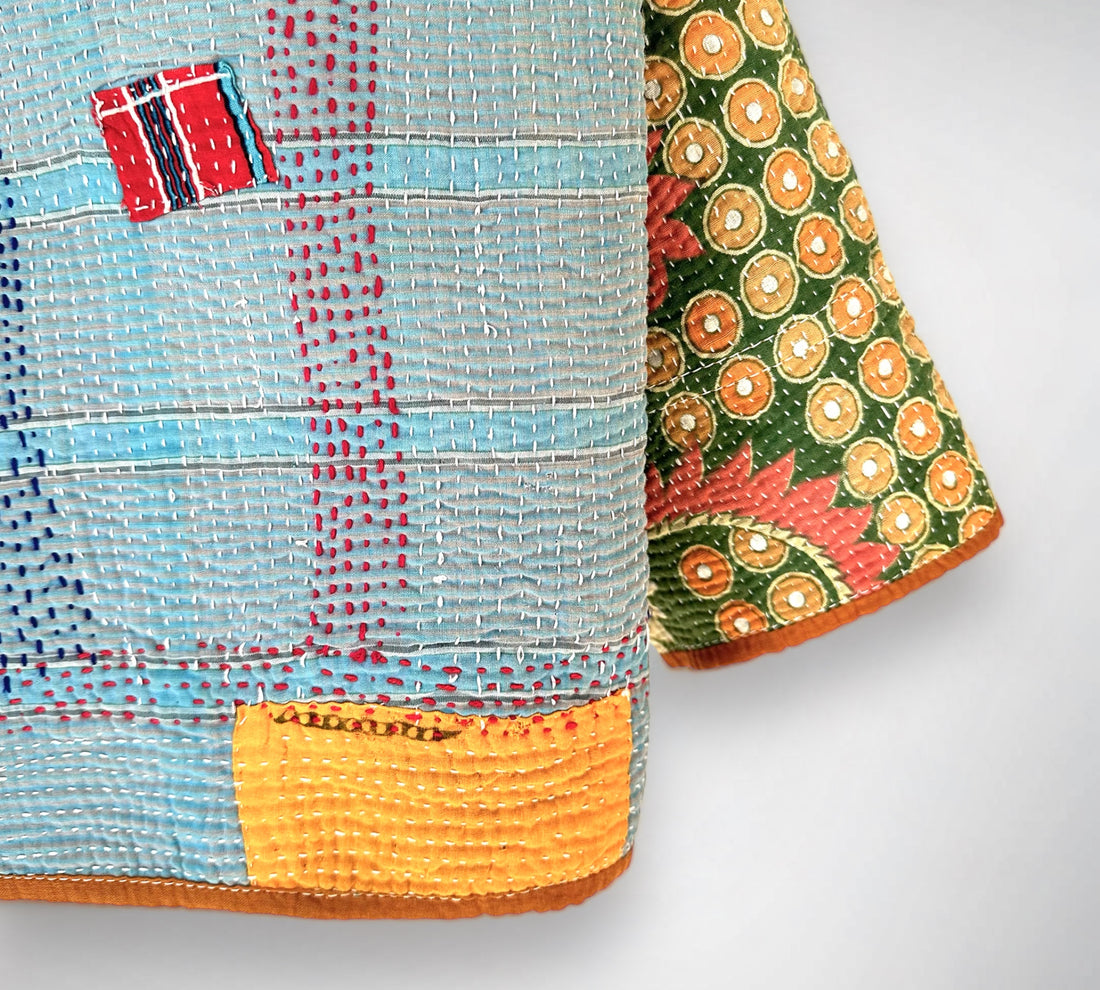
The Art of Mending: A Journey through Time and Technique of Sashiko, Kogin, Boro, Rafoogari, and Kantha
Share
Let us explore the fascinating world of mending and turn our attention to the timeless craft of repair. Uncover the story of Sashiko, Kogin, Boro, Rafoogari, and Kantha a timeless practice infused with heritage and innovation, as we explore the soul of mending and take a journey through its fascinating history in this post.
What is Mending?
Mending is the art of repairing or patching something. It involves a variety of techniques, including sewing, embroidery, and patchwork. Mending is not just about fixing a tear; it's about restoring worn-out items and making them usable again. Whether it's a cherished Kantha jacket or a quilt passed down from your grandmother, mending can breathe new life into these items and restore them to their former glory.
The History of Mending
Mending is an ancient practice. It has deep roots in human history. In the days before fast fashion, making cloth -as Kantha quilts– was a painstaking process requiring skilled craftsmanship. Making clothes was a significant investment of time and resources. Unlike today, clothing was not discarded after a single season. It was carefully cared for and treasured. Mending was an essential skill that allowed people to prolong the life of their clothing and make the most of their limited wardrobes. It was passed down through generations and both men and women refined the art of mending.
While historical records may be limited, mending remains a prevalent practice across diverse cultures, each cultivating unique techniques and aesthetics in the art of repair. Let’s look at some notable examples.
Distinguishing Visible and Invisible Mending:
Mending can be broadly classified into two primary categories: visible and invisible mending.
Invisible mending involves the intricate reweaving of fabric to seamlessly repair garments, making the repaired area virtually undetectable from the front. Conversely, visible mending embraces repair as a visible element of design. It provides an opportunity for creative expression and often adopts an ornamental form like on Kantha quilts. Visible mending is comparatively less time-consuming and allows individuals to infuse their personal style into the repair process. Techniques such as Sashiko or Kantha stitching have gained traction in recent times, offering unique and artistic approaches to mending.

Source: https://taanka.hu/hu/collections/nazra-jackets
Sashiko is the Japanese embroidering technique that has been gaining much attention in the western world lately. The name means 'little stabs' in Japanese. Sashiko is all about repairing and strengthening fabric with a simple running stitch. It's been around since the Edo period (that's 1603 to 1867 AD), and one of its defining features is the use of beautiful blue indigo fabric.

Source: http://www.metmuseum.org/art/collection/search/50806
Another fascinating Japanese technique is Kogin. It comes from the northern regions of Japan. In Kogin, craftspeople use a counted thread method to finish garments. Just like Sashiko, it's all about being super precise with the number of stitches.

Source: https://www.romordesigns.com/shop/kogin-counted-thread-embroidery-class-and-kit
Boro, the third fantastic Japanese tradition to list in this post, is about using dense patchwork to make clothes last longer or more comfortable. It's all about covering holes or tears with pieces of fabric and stitching them together with simple running stitches. Boro pieces are so strong they can last for generations! And they are often made from beautiful blue indigo fabric with striking white stitches. It's just one of the many fascinating ways that people have mended clothes throughout history and around the world.

Boro
Source: https://www.capitalquilts.com/module/class/222815/the-art-of-boro-stitching
Kantha embroidery, a traditional craft from India, involves sewing layers of old fabric together to create new textiles such as quilts and blankets. The technique celebrates the transformative power of mending, turning "rags" into valuable and beautiful creations.

Source: https://taanka.hu/hu/collections/nazra-jackets
Also originated in India, Rafoogari is all about weaving together the visible and invisible ways of repairing clothing. Often referred to as the art of 'healing clothes', Rafoogari artisans effortlessly combine embroidery with delicate repairs. They're particularly famous for their ability to bring treasured pashmina shawls back to life.

Rafoogari
Source: https://www.architecturaldigest.in/content/priya-ravish-mehra-rafoogari/
The Advantages of Mending
Mending offers a unique blend of practicality and creativity, making it advantageous in various ways. Firstly, it celebrates the artistry of repairing garments, transforming flaws into distinctive features that tell stories of resilience and care. By proudly showcasing repairs, visible mending promotes sustainability, encouraging a shift away from disposable fashion towards a mindset of cherishing and preserving clothing. Additionally, visible mending fosters a sense of connection to heritage and culture, as techniques like Boro and Kantha embroidery highlight the rich traditions of different societies. In essence, visible mending not only extends the lifespan of garments but also fosters creativity, sustainability, and community spirit in the process, therefore we would like to encourage you to mend your clothes as much as possible.:)
